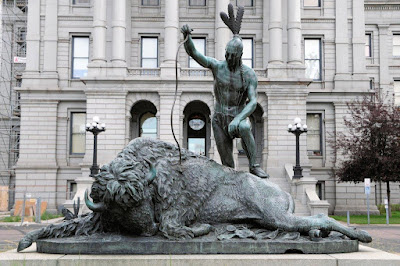State Capitols – Denver, Colorado - Outside
Colorado Capitol in Denver (22 August 2011)
I’m watching the NBA finals and realize the game is being played in a state capital that I have not yet presented. Also, following the plain and ordinary Alaska capitol with one of the more elaborate state houses will be fun. I will suggest that the Colorado capitol in Denver is the shiniest of them all. But first, the exterior.
Gold has a way of influencing an area’s geo-political prospects. For example, in 1848, the territory of California was annexed as part of the spoils of the war with Mexico. That same year, gold was discovered there. Two years later, after a massive influx of prospectors and settlers, California became our 31st state.
Part of what is now Colorado came to us through the Louisiana Purchase in 1803 and most of the rest was added after we beat up Mexico. Spanish settlers who had been there for three hundred years and the native tribes that had been there for thousands more were minor impediments to our ‘Manifest Destiny’...and nothing speeds up the Manifest Destiny timeline like gold.
In 1858, gold was discovered near Denver. Three years later, Congress formally created the Colorado Territory. Fortune-seekers swarmed in. In 1876, the ‘Centennial State’ became our 38th state, as the nation celebrated the 100th anniversary of the Declaration of Independence.
The capitol is known for its use of Colorado materials...the foundation is sandstone from Fort Collins and the exterior is granite from Gunnison. Above the three-story building is a magnificent dome that tops out at 272 feet from the ground. The architect Myers wanted to cover the dome with copper. Since Colorado does not produce copper, the state mining association donated 200 ounces of 24 karat gold leaf to cover the dome. In 1906, that cost $14,680. The gold has been re-done at least four times since then; the most recent, in 2012, required 65 ounces of pure gold at a cost of $125,000.
It is interesting to note that the use of all that local stone had its limits. The dome’s walls and columns are cast iron made to look like granite. They figured that more stone at that height would be too heavy to support.
The names of many soldiers are inscribed below the statue. Though not yet a state, Colorado sent troops to fight on the Union side. Given the date of the installation, one wonders if the pending 50th anniversary of the conflict heightened interest in memorializing the time. Being the most cataclysmic event in our history, it should. Besides, at that time, the former Confederate states were throwing up glorious monuments by the score.
Along with the Kansas capitol in Topeka, Colorado’s capitol is the only other one with tours that include taking you up into the dome. From there one can see the Denver City and County Building and the Front Range of the Rockies in the distance.
First exhibited at the Columbian Exposition in Chicago in 1893, this is the first sculpture placed on the capitol grounds and presents a sympathetic view that Native American life was fading away. Searches will show the work is also called ‘Closing of an Era’ (which makes more sense) but the state’s own reference materials omit the middle words.
A few blocks from the capitol is this piano on the sidewalk. People are invited to play it. Sweet street scene. Can’t imagine this working in some rough neighborhoods I know or in the sub-tropical humidity of the deep South.
Next, the gleaming interior.









0 Comments:
Post a Comment
<< Home